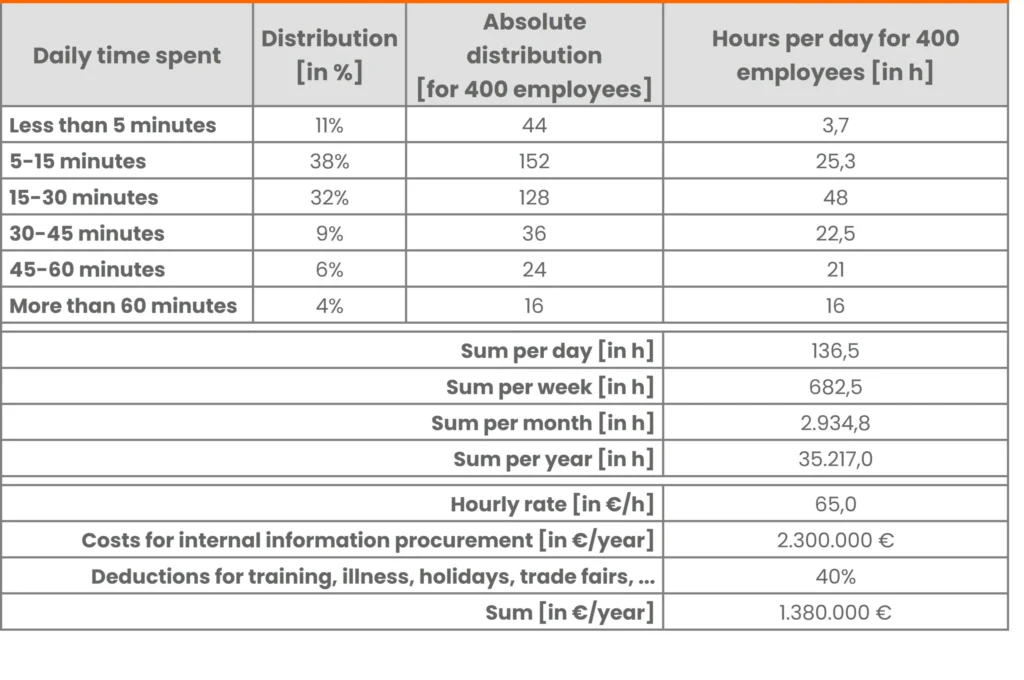We’ve all been there – you’re looking for information and can’t find anything in the company’s internal systems on your own. So you start asking your colleagues for help. Once you have found the right document, it still takes an eternity to write an e-mail, etc. based on it. Employees already spend 25 minutes a day on digital searches – a figure that has risen by 77% in recent years. These challenges can be solved excellently by a Smart Search.
Table of Contents
What is a Smart Search?
A Smart Search specifically utilises technologies from the field of artificial intelligence, in particular natural language processing, to make internal company data efficiently accessible. This search technology optimises the search for information by intelligently processing natural language.
This blog post focuses in particular on internal company searches, also known as enterprise search in technical jargon. An alternative application of Smart Search would be its use on the web, for example, as is familiar from internet search engines such as Google, Bing or Ecosia.
With a Smart Search, it is particularly important that the company’s internal expertise – taking into account any access rights and regulations such as the GDPR & Co – is made quickly and easily accessible
From a technical point of view, there are 3 main methods that are used for internal searches:
- Federated search, which controls the search interfaces of other systems
- Keyword-based search, which is often supplemented by certain NLP techniques, but is not really “intelligent”
- Intelligent or LLM-based search, which searches for information on a semantic basis
Smart Search in combination with generative AI
The current desire of many companies is to chat with in-house expertise. From a technical perspective, there are three primary technical options for chatting with internal expertise:
- Training an in-house AI model
- Building a retrieval augmented generation model
- Combining a Smart Search with retrieval augmented generation
We have already discussed the various advantages/disadvantages in this blog article. The best technical answer to the question of whether internal content is better retrieved via a Smart Search or an AI chatbot is not an either/or question. Ideally, you should combine both systems in order to combine the respective weaknesses of one or the other technology.
For example, the Smart Search can take care of things like access rights, retrieval of relevant information from the various data silos and indexing, while the AI chatbot ensures ideal delivery to the user and prepares the information in the form that the employee needs it.
Added value of a Smart Search
Before talking about the added value of a Smart Search, you should be aware of the pain points.
To this end, we conducted a survey in a medium-sized company with 400 employees and asked about various topics. One of the questions was, for example, what the consequences of a bad search are. These were some of the answers:

Results of our studies on the employees view of the consequences of a bad search
What is very clear: Employees are very aware of how high the costs are for the company. In addition, information that is difficult to access not only leads to poorly implemented digital processes or duplication of work, but above all to frustration on the part of employees. Especially in times of a shortage of skilled labour and rising employee expectations of the company’s internal software systems, this is a bad reason to lose potential employees.
For a company with 400 employees, poorly accessible information can quickly result in costs of over €1,400,000 per year.

This illustration was originally taken from this article
A Smart Search can reduce digital search time by up to 40%, as we have been able to show with various customers. This means that €550,000 can be saved in employee search time alone. In combination with generative AI, additional added value can result from the significantly faster provision of formulated or reformulated texts. There are various use cases for this in the company, which we explain in more detail on our website.
Another added value is that employee satisfaction with the internal IT systems increases significantly. Collaboration in the various teams also increases, as relevant information can be found much more easily.
Integration of a Smart Search into existing systems
Anyone implementing a Smart Search should consider 2 things:
- Which systems should the Smart Search be able to search?
Normally, standard systems work with standard connectors that are able to reliably take existing access rights into account. Some systems, such as amberSearch, have an interface that can also be used to connect customised systems.
- How should the software be made available to the user?
Thanks to B2C apps such as Instagram, Facebook and the like, users today have very high expectations of the user experience of business software solutions. It is therefore important to ensure that software is made available to the user where the employee works on a daily basis. This can mean that the software must be available via team app, web app, desktop app or, among other things, mobile or via Chrome plug-in – all options that amberSearch offers.
A complete overview of the integrations can be found here.
The effort involved in implementing a Smart Search
One question that quickly arises is how to host the software. Typically, LLM-based searches in particular have to be hosted as a managed service. As LLMs have quite high hardware requirements, they are rarely feasible for SMEs. The advantage, however, is that a managed service solution can be implemented with a technical effort of 4 hours.
Incidentally, amberSearch is one of the few providers to have full ownership of the AI models and would therefore also be able to host an LLM-based search on premise if sufficient hardware were available.
